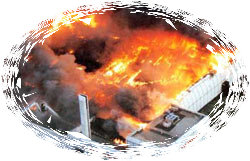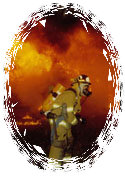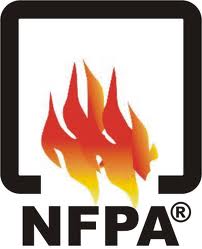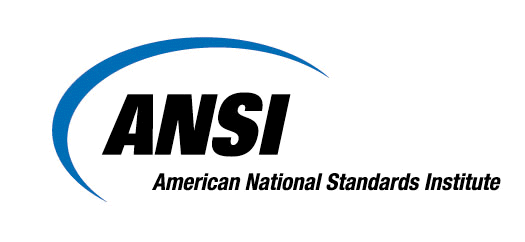



Fire Protection > Standpipe Riser
Standpipe Systems
Many high-rise or other large buildings have an internal system of water mains (standpipes) connected to fire-hose stations and landing valves. Trained occupants or employees of the building management operate the hoses until the fire department arrives. Fire fighters can also connect their hoses to outlets near the fire.
Types
There are two types of standpipes: "wet" standpipes and "dry" standpipes.
A "dry" standpipe is so named because the pipe usually carries no water or water pressure: the pipe is pressurized only during a fire emergency. The dry standpipe is connected to a fire hydrant or fire engine on the ground, and carries the water to an upper floor, generally the floor below the fire floor . A Hoseline is then connected at this location. Dry standpipes, when present, are generally located in the stairwell of a building.
A "wet" standpipe, on the other hand, is filled with water and is pressurized at all times. In contrast to dry standpipes, which may be used only by firefighters, wet standpipes may be used by building occupants. Wet standpipes generally already come with hoses so that building occupants may fight fires quickly.
Advantages
Standpipes resolve a number of difficulties in getting water to the upper levels of a structure, even when it is theoretically possible to use hoseline to accomplish this. Standpipes go in a direct up and down direction rather than looping around the stairwell, greatly reducing the length and thus the loss of water pressure due to friction loss . Additionally, standpipes are rigid and do not kink , a dangerous problem which can occur when hoseline is improperly laid on a stairwell. Finally, laying hose up a stairwell takes time and this time is saved by having a fixed structure already in place.
Wet Riser System
The wet riser system described below is a typical installation in a high-rise building. It is used to supply water from the wet riser water tank, through wet riser pipes, distributed to each floor, and ending at the canvas hoses and hose reels.
The pipes supplying water to the hoses are pressurized all the time. Three pumps supply the water from the tank to the hoses. The pumps are the duty pump, the stand-by pump, and the jockey pump. Pressure switches along the pipe control the starting of each pump.
The wet riser canvas hoses are located at each lift lobby. Each canvas hose has a diameter of 65 mm and a length of 30 m. When the hoses are in use, the pressure at each floor is controlled by landing valves that return excess pressurized water back to the wet riser tank through drain pipes.
The hose reels are also located at each lift lobby. Each hose reel has a diameter of 25 mm and a length of 30 m. Pressure reducers are installed at the end of each wet riser pipe to supply a lower pressured water to hose reels.
When the valves of the hoses are opened, pressurized water will shoot out through the nozzles of the hoses. The pressure in the piping will drop. The pressure switches at the pump room will sense the drop in pressure and the pumps will start to pressurize the pipe again. A typical system for a high-rise building is described below. The pressures are monitored at the pump room to control the pumps.
Hose Reels

Hose Reel is a metal reel, permanently connected to the water supply, on which is wound rubber tubing having an internal diameter of 12.5mm nominal or 20mm nominal, which can be used for first aid fire-fighting purposes.
Landing Valves

Landing valves are a firemen station in each landing of the building floor which is placed on the wet riser, firemen can conect the fire brigade 1 1/2 " or 2 1/2 '' hoses to the valve to supply them by the requiered flow and pressure.
Supplies from standpipes on hydrants

For approved purposes and subject to such conditions as the Engineer may prescribe, an extraordinary supply of water may be given by means of a standpipe to be placed upon a specified fire hydrant. Application to the office of the Engineer shall be made for such supply and for the hire of a standpipe if supplied by the local authority.
Wet Riser Pumps

Jockey Pump
The first pump to start will be the jockey pump. The controlling pressure switch is set to start the pump at a pressure of 150 psi and stop it when the pressure reaches 230 psi.
If a small leak exist in the wet riser piping - either on the wet riser or hose reel - the pump will start in order to compensate for the leak.
Duty Pump
If the pressure drops below 125 psi, this means a wet riser landing valve or a hose reel gate valve has been opened. The pressure switch that senses this set pressure activates and starts the duty pump.
Stand-by Pump
If for any reason the pressure continues to drop below 125 psi, it means either the duty pump has not started or is not available (under repair...etc.). The stand-by pump then takes over the function that is not performed by the duty pump. The stand-by pump is set to cut-in at 95 psi.
Once the water flow is not needed any more the pressure builds up in the piping network. The duty or stand-by pumps stops after the cutout pressure is reached at 220 psi.
The jockey pump continues to run until the system pressure reaches its cutout pressure of 230 psi.
For a low building, the system will be less complicated. However, the purpose of supplying water to the fire fighting hoses is maintained.
Sources:
NFPA 1 Fire prevention code
Uniform fire code 1997
Retrieved from " Wikipedia "










